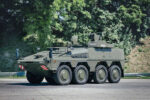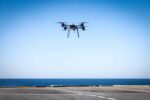The U.S. Air Force Research Laboratory (AFRL) has demonstrated a directed energy weapon capable of disabling swarming drones in seconds using high-power microwaves. This milestone highlights a growing shift toward scalable non-kinetic counter-unmanned aerial system (C-UAS) solutions as drone threats proliferate across modern battlefields.
AFRL’s THOR System Demonstrates Operational Maturity
The Tactical High Power Operational Responder (THOR), developed by AFRL at Kirtland Air Force Base in New Mexico, is a ground-based directed energy system designed to defeat multiple small unmanned aerial systems (sUAS) simultaneously using bursts of high-power microwave (HPM) energy. In recent field trials conducted at an undisclosed location outside the continental U.S., THOR successfully neutralized a swarm of drones within seconds of activation.
According to AFRL’s official statement and corroborating reports from defense sources including Breaking Defense and Defense News, the test involved dozens of Group 1 and Group 2 class drones—typically quadcopters and fixed-wing UAVs under 25 kg—flown in coordinated attack formations. The HPM pulses disrupted their onboard electronics and flight control systems without requiring kinetic interceptors or line-of-sight tracking.
THOR’s design prioritizes rapid deployment and autonomous operation. The system fits inside a standard 20-foot ISO container and can be deployed by a C-130 aircraft. It is powered by a generator and features an electronically steered antenna array for wide-area coverage. Operators can engage targets via a touchscreen interface with minimal training.
Electromagnetic Pulse Weapons vs Traditional Kinetic Defenses
The emergence of drone swarms as low-cost precision threats has challenged conventional air defense architectures that rely on expensive interceptors or limited-rate-of-fire guns. Systems like THOR offer several advantages over traditional SHORAD solutions:
- Cost-per-shot: Each HPM pulse costs significantly less than interceptor missiles or even guided projectiles.
- Multi-target engagement: THOR can disable dozens of drones simultaneously within its beam arc.
- No collateral damage: As it emits non-lethal energy bursts, it avoids explosive fragmentation risks near sensitive infrastructure or friendly forces.
- Silent operation: Unlike gun-based systems or lasers that require line-of-sight burns over time, HPM effects are instantaneous and invisible.
However, limitations persist. HPM weapons are line-of-sight dependent and may be affected by atmospheric conditions such as rain or humidity that attenuate microwave propagation. Moreover, hardened UAVs with shielded electronics may resist some effects unless exposed directly to peak field intensities.
C-UAS Doctrine Evolution: From Point Defense to Area Denial
The successful demonstration of THOR underscores a doctrinal shift from point-defense toward area denial against drone threats. Instead of shooting down one UAV at a time—as with kinetic SHORAD systems like NASAMS or Avenger—directed energy enables volume effects against massed sUAS attacks.
This capability is particularly relevant against asymmetric actors employing commercial off-the-shelf (COTS) drones modified for ISR or loitering munition roles. In Ukraine and Syria, both state and non-state actors have used FPV drones en masse to saturate defenses—highlighting the need for scalable C-UAS layers that include electronic warfare (EW), jamming/spoofing tools, kinetic interceptors like Coyote Block II/III, and now high-power microwave weapons like THOR.
The U.S. Department of Defense has increasingly prioritized layered counter-drone architectures under programs such as the Joint Counter-small Unmanned Aircraft Systems Office (JCO). In this context, AFRL’s work on THOR complements other efforts like Raytheon’s Phaser system and Epirus’ Leonidas platform—both also leveraging HPM technology but differing in power output profiles and targeting methods.
Toward Fieldable Directed Energy Weapons
The field trial marks one of the few known operational deployments of an HPM-based weapon outside lab settings. While laser weapons such as HELIOS or DE M-SHORAD have received more public attention due to their visible beams and integration on naval/land platforms, microwave-based systems offer unique advantages for close-in defense against small airborne targets.
THOR was developed under AFRL’s Directed Energy Directorate with support from Leidos as prime contractor since 2019. The system has undergone multiple test cycles including at White Sands Missile Range since early prototypes were unveiled publicly in 2020–2021. Its current configuration represents Technology Readiness Level (TRL) 7–8 — indicating near-operational maturity pending further ruggedization for contested environments.
A follow-on program known as “Mjölnir” is already underway to transition lessons learned into a more robust production-ready variant with improved mobility, power efficiency, targeting fidelity, and integration into broader command-and-control networks via Link-16 or other tactical datalinks.
Strategic Implications for Future Conflicts
The ability to rapidly neutralize drone swarms using non-kinetic means could reshape battlefield dynamics across multiple theaters—from protecting forward operating bases (FOBs) to defending critical infrastructure during gray-zone conflicts where attribution remains ambiguous but effects are real.
Nations including China, Russia, Iran—and increasingly non-state actors—are investing heavily in swarm-enabled drone tactics leveraging AI-driven flight coordination algorithms. A single operator controlling dozens of sUAS poses significant challenges unless defenders can engage en masse without depleting finite munitions stocks or risking fratricide from overlapping fires.
If scaled effectively into mobile platforms such as JLTVs or Strykers—or integrated into naval CIWS suites—the THOR concept could become part of standard force protection packages alongside radar cueing sensors like KuRFS or EO/IR trackers feeding into fire control loops powered by AI-enabled threat classification engines.
Conclusion
The AFRL’s successful deployment of the THOR electromagnetic weapon signals an inflection point in directed energy warfare capabilities against airborne threats. As adversaries continue exploiting low-cost UAVs for ISR and strike missions at scale, scalable non-kinetic defenses will be essential to maintain airspace dominance below traditional radar horizons.
If transitioned swiftly into service-ready configurations with robust command integration—and if cost-effective sustainment models emerge—systems like THOR could become indispensable elements within future layered air defense ecosystems across all domains: land bases, naval task groups, urban centers under hybrid threat conditions alike.









